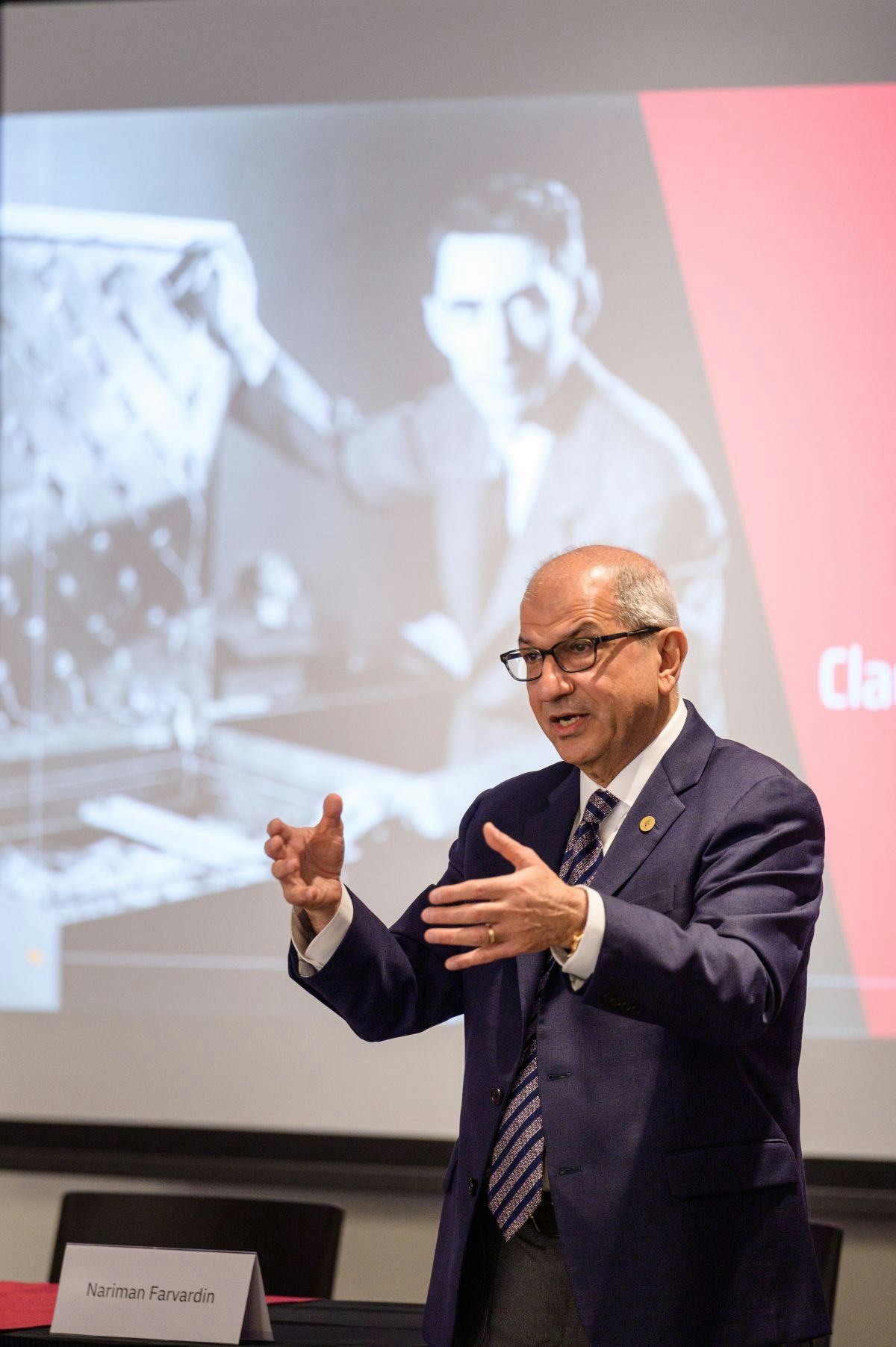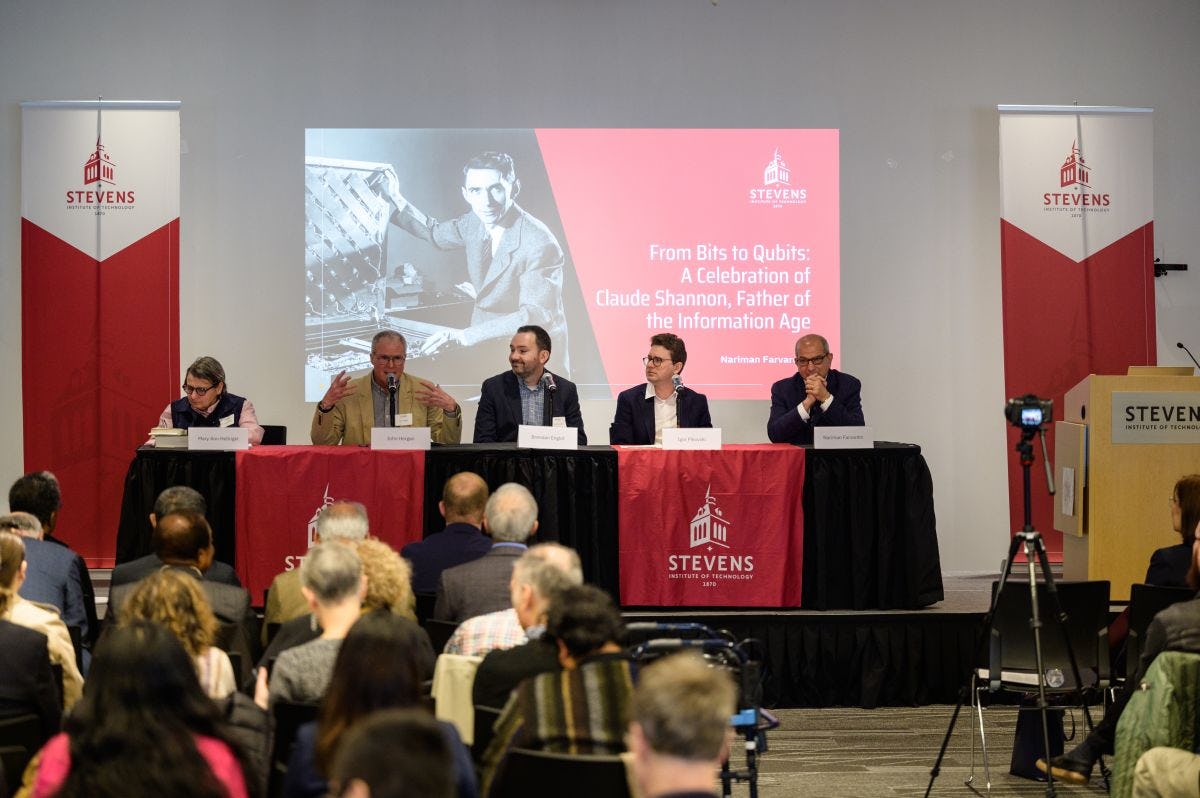Stevens, IEEE History Center celebrate – and spread the word of —the life and legacy of Claude Shannon, Father of the Information Age
The idea that information can be encoded in 1s and 0s. Early AI machines. And theories that laid the groundwork for digital communications networks now lacing the Earth. These are just some revolutionary contributions of “the least known genius of our time.”
This Father of the Information Age received a richly deserved celebration and recognition in early April, when Stevens Institute of Technology honored Bell Labs and MIT luminary Claude Shannon.
Co-sponsored by the IEEE History Center, “From Bits to Qubits, a Celebration of Claude Shannon, Father of the Information Age,” saw Stevens students, faculty, staff, alumni, IEEE members and the public turn out to learn about Shannon’s groundbreaking work in information theory, how this work enabled innovations in digital communications, AI and quantum computing — and how his work influences researchers today, many decades later and more than 20 years after his death in 2001 at age 84.
The morning’s speakers dived into not only Shannon’s technical achievements but also his delightful creativity. This mathematician and computer scientist was a passionate tinkerer, a juggler and a builder of unicycles, among various other inventions. He was known to juggle and ride his unicycle — at the same time — along the long corridors of Bell Labs in Murray Hill, New Jersey. But he also built chess-playing machines and a mechanical mouse that could run through a maze, helping to create the field of artificial intelligence.
Shannon's work in secret communications during World War II for the Allies became a foundation for modern cryptography, while his master’s thesis set a foundation for modern circuit design. But his most profound contributions came in information theory. Shannon, who had an early understanding of encoding language in 1s and 0s, showed that information could be quantified and delivered reliably over imperfect communications channels — unleashing a communications revolution.
“Claude Shannon is the least known genius of our time,” said Stevens President Nariman Farvardin.
With Farvardin as keynote speaker, the event had the feel of a lively university seminar helmed by a seasoned professor. Farvardin, an IEEE life fellow, multiple patent holder and longtime professor, has research interests in information theory, multimedia signal compression and transmission and wireless networks. He calls Shannon his foremost intellectual influence.
The event also featured speakers Mary Ann Hellrigel, institutional historian and archivist with the IEEE History Center; and Stevens professors John Horgan, director of the Center for Science Writings at Stevens and a longtime science journalist; Brendan Englot, associate professor of mechanical engineering and director of the Stevens Institute for Artificial Intelligence; and Igor Pikovski, assistant professor of physics. All participated in a panel discussion moderated by Horgan.
In the morning’s first presentation, Hellrigel shared numerous IEEE and other resources that chronicle Shannon’s work and achievements, from the Wiley-IEEE Press publication Claude Elwood Shannon: Collected Papers, to a transcript of an IEEE oral history conducted in 1982, plus an overview of his many awards. Among them: the National Medal of Science, the highest recognition that the nation can bestow on scientists and engineers, presented to him in 1966 by President Lyndon B. Johnson.
President Farvardin’s keynote address was a mixture of university lecture (there were math formulas) and a vivid memory of Shannon.
Attending an IEEE conference in Brighton, England, in 1985 as a young professor, Farvardin and other attendees were electrified as Shannon and his wife, Betty, made a surprise appearance. Research “dignitaries” lined up for Shannon’s autograph. Farvardin was too shy but, as luck would have it, he found himself seated next to the Shannons during the evening’s banquet. He spent two and a half hours hearing Shannon’s life story.
“That was one of the most memorable experiences of my life,” Farvardin says.
“He was a very humble man. The most memorable story ... from the conversation was how proud he was of his ingenious designs of unicycles! ... He was intentional in designing unicycles that were difficult to ride.”
Farvardin offered a brief biography of Shannon. Born in 1916, the Gaylord, Michigan, native earned bachelor’s degrees in mathematics and electrical engineering from the University of Michigan in 1936 and his master’s degree and Ph.D. in 1937 and 1940 from Massachusetts Institute of Technology. In 1941 he joined the mathematics department at Bell Labs — “a mecca of brilliant minds,” Farvardin said — with which he was affiliated until 1972. He joined the MIT faculty in the university’s Research Laboratory of Electronics in 1956, serving until 1978.
Farvardin noted Shannon’s early successes. He called Shannon’s master’s thesis “the most important master’s thesis ever written by anyone” because it set a foundation for digital circuit design.
Farvardin discussed a basic communication problem that Shannon’s research aimed to address: Under what conditions can reliable communication happen and, if it’s not error-free, what’s the best that can be achieved?
Shannon’s landmark 1948 paper relied upon mathematics to quantify information and show that information could be delivered reliably over communication channels — a revolution.
Farvardin went on to show the impact of Shannon’s work on everyday life, from zip files and file storage to coding in 3G, 4G and LTE wireless telephony and satellite communications to MP3 technology.
“This is the influence of one man on the way we live,” he said.
“Shannon was the first person to start thinking about things in digital forms, in 0’s and 1’s,” Farvardin added. “This is revolutionary.”
Horgan noted that Shannon’s work in information theory was greatly influential in many fields, including physics and neuroscience.
He related a story of when he interviewed Shannon in 1990 for Scientific American. Horgan remembers him as shy, self-deprecating and not interested in discussing his career. But he did want to discuss his gadgets and showed Horgan a room of his creations, including the mechanical mouse and maze and chess-playing machines important to the origins of AI.
One of the most remarkable things about Shannon was his early insight into the potential of non-numerical computing and thinking of using analog circuits as a vehicle for performing logical reasoning, Englot said.
“In 1937, just the idea of using computers for non-numerical computation was kind of revolutionary.” Chess-playing machines — a machine that can think — and his co-authoring of a seminal proposal for a summer research project in AI at Dartmouth also made him an AI pioneer, Englot said.
Igor Pikovski also noted Shannon’s “very profoundly impactful” influence on modern physics.
“What he created was a synergy that people could bounce off of,” Hellrigel added. “He built a community of like-minded people” who went on to expand upon his important work.
An audience question-and-answer session followed, where participants called for more support for fundamental research and more room for “blue-sky” thinking like Shannon’s.
Carlos Ramos Ph.D., ’02, a data scientist with MITRE, said that Shannon’s work has shaped his own. He sees the deep value of fundamental research like that of Shannon’s.
“We have to find other ways to sponsor research,” he says. “We still need companies that are not [so] commercial.”
First-year computer engineering student Michael Moschello was inspired to learn more about this giant in information theory and how he has influenced research happening today.
“I was able to learn firsthand how Stevens is pushing the boundaries of technology, especially in breakthrough AI research whose foundations, I learned, were laid by Shannon,” he said.
“This is not something you learn in the classroom,” said Stevens graduate student Harshil Thakkar. “He’s up there with Newton and Einstein! It shows what’s possible.”





